Hitting report: Carlos Correa suffering from lack of power at the plate
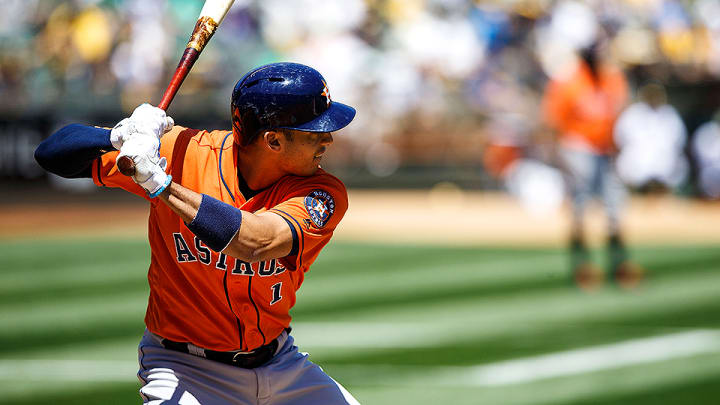
Get all of Michael Beller’s columns as soon as they’re published. Download the new Sports Illustrated app (iOS or Android) and personalize your experience by following your favorite teams and SI writers.
Houston’s terrible play has been of the most surprising things so far this year. The Astros were roundly seen as a World Series favorite before the season, and instead begin May tied with the Twins for the worst record in the AL and second-worst mark in the majors. If they don’t right the ship soon, they could go down as this season’s most disappointing team.
One development that would certainly help is Carlos Correa rediscovering his power stroke. The reigning AL Rookie of the Year Award winner hit three homers in his first two games, making anyone who tabbed him as a preseason MVP pick look good. He hasn’t left the yard since, and is now slashing .258/.383/.416—still respectable, but a far cry from where he is supposed to be.
• WAIVER WIRE: Best options for replacing the suspended Dee Gordon
His lack of power is the biggest cause for concern. His pop routinely graded as his best tool when he was making his way to the bigs, and he showed why immediately upon arrival. Correa slugged .512 with 22 homers and an isolated slugging percentage of .233 in 432 plate appearances last season. We talk about small sample size all the time and do what we can to make sure the noise doesn’t drown out the actual message, but 432 plate appearances aren’t anything to dismiss. Correa was also 39th in the majors with an average fly ball distance of 297.74 feet. When he hit the ball in the air, it typically went a long way.
Nationals’ Max Scherzer is struggling, but his problems are fixable
It’s not just that Correa is hitting fewer home runs—he’s also hitting the ball much shorter than he did last year. Correa’s average fly ball distance sits at 274.67 feet, 7.7% shorter than it was in his rookie campaign. His line-drive rate has fallen off a cliff all the way down to 15.9% from 22.4%, and he’s pulling the ball less frequently than he did last year. In general, players are going to hit more homers to the pull side than back up the middle or to the opposite field.
Part of Correa’s early-season power outage likely owes to the fact that he’s swinging less often than he did last year. Correa’s focus of getting on base is already paying dividends. He has a 15.9% walk rate and .383 OBP this season, both of which are up dramatically from 2015. He has cut his outside-swing rate by eight percentage points, and is swinging at two-fifths of the pitches he sees after being at 44.8% last season. That steep a drop in swing rate necessarily means fewer balls in play, which likely means fewer fly balls, which almost always means fewer homers. That also isn’t a huge issue, especially for a player as talented as Correa who’s going to get his, irrespective of the volume of balls in play.
It’s possible there’s something else at play here. Take a look at the following screenshots. The first is from last August, and the second is from the most recent Sunday, during which Correa went 0-for-4 with a walk in a win over the A’s.
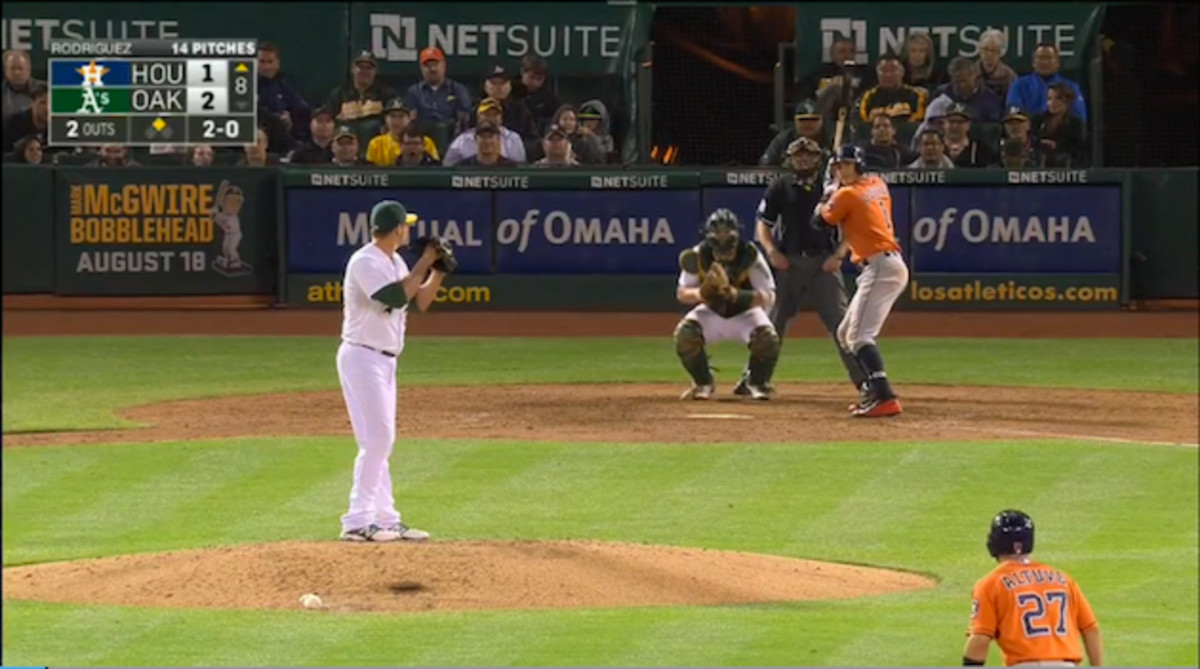
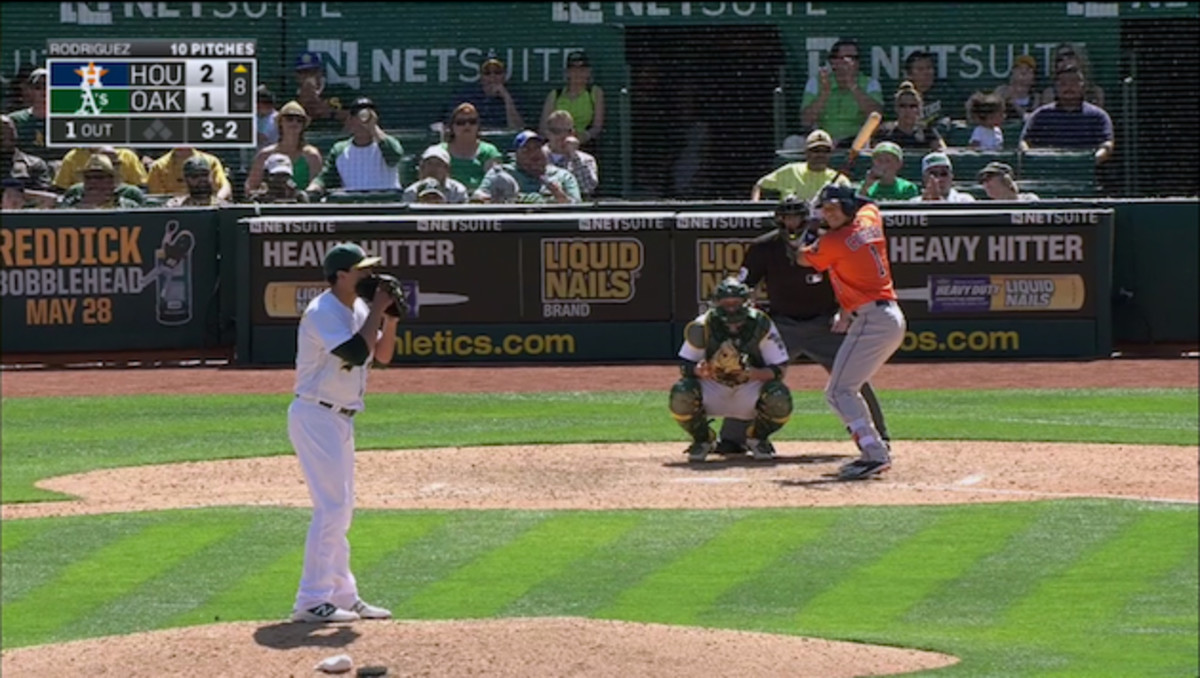
Correa appears to be set up a bit closer to the plate this year than he was as a rookie. I deliberately pulled at-bats from the same park to guarantee the same camera angle. The fact that it’s the same pitcher, Fernando Rodriguez, is a happy coincidence, especially when we take this to GIF form.
Hitters who trust their ability to get their hands inside the ball are ones who can, and will, crowd the plate. Correa isn’t right on top of the plate this season, but it does he appear he has cheated in a not-insignificant amount. That also seems to be having an effect on his ability to get around on inside pitches. The first zone profile below tracks Correa’s ISO by zone from 2015. The second is from this year. Remember, these are from the catcher’s perspective, so the left side represents the inner portion of the plate for a righty like Correa.
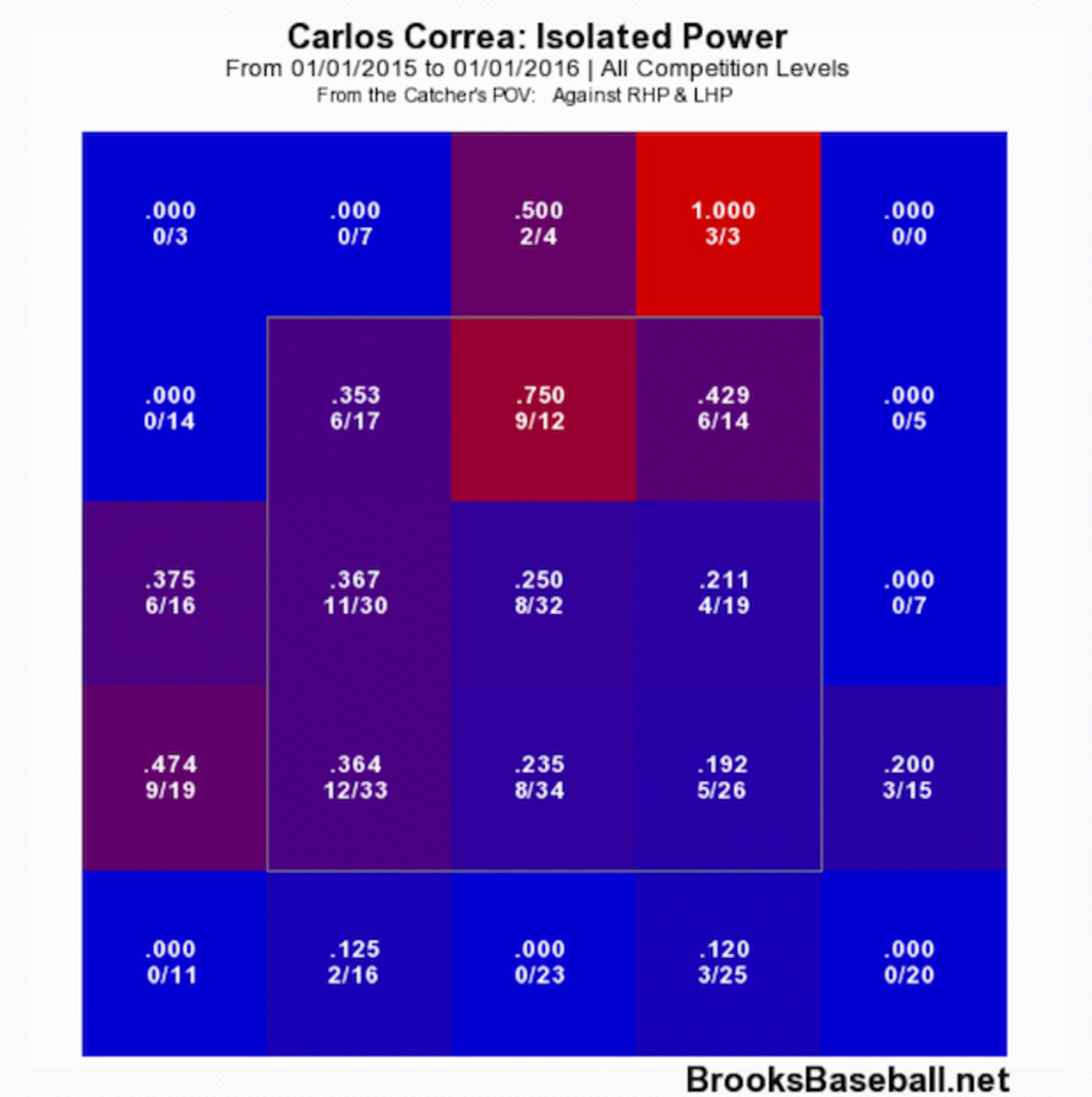
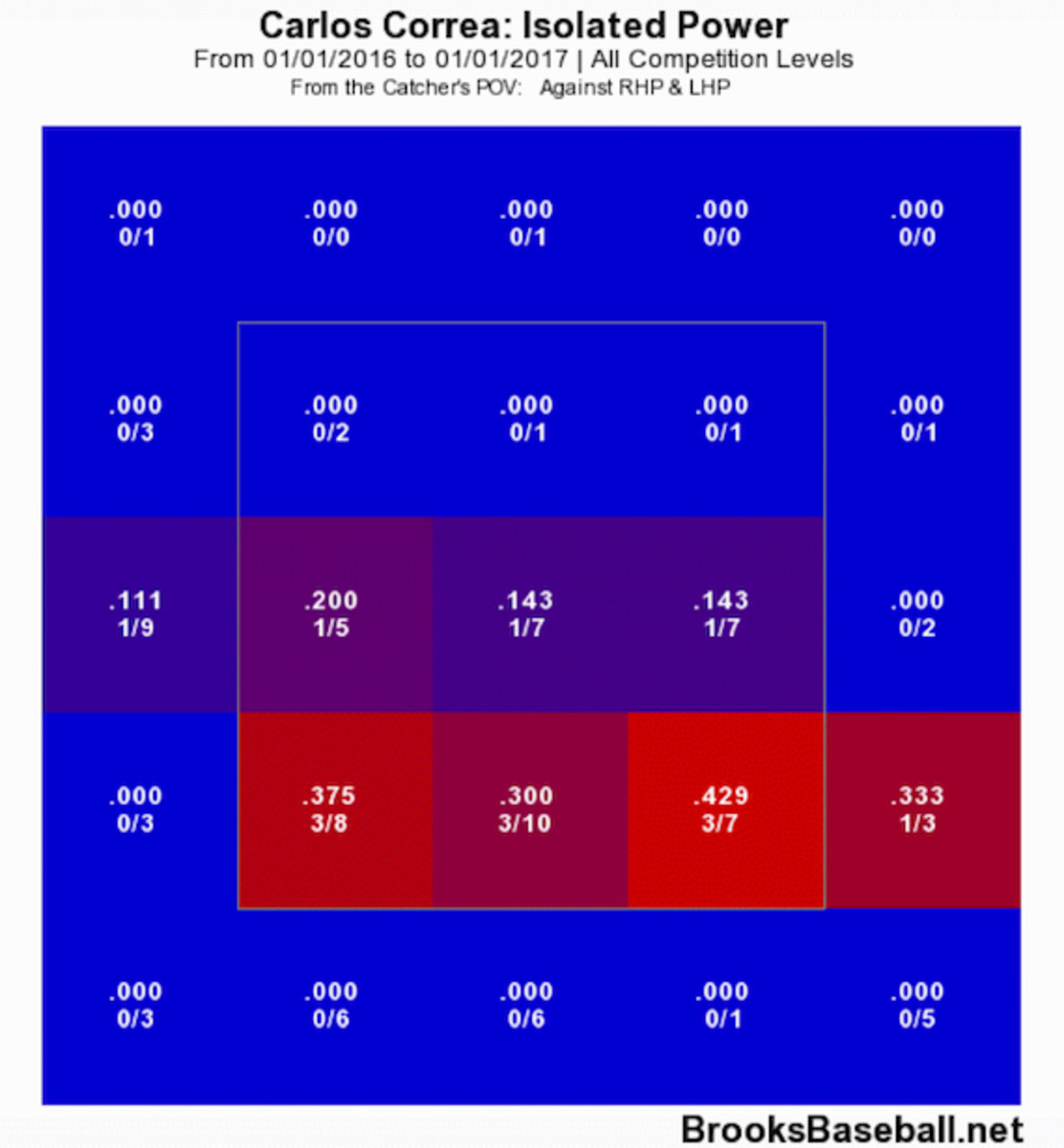
All that purple accompanied by numbers north of .300 on the inner third in 2015 is great. This year, Correa can’t buy an extra-base hit on an inside pitch. You can probably guess where we’re going next. Pitchers are attacking Correa on the inner third and off the plate inside more frequently than they did last season. Here’s the visual proof.
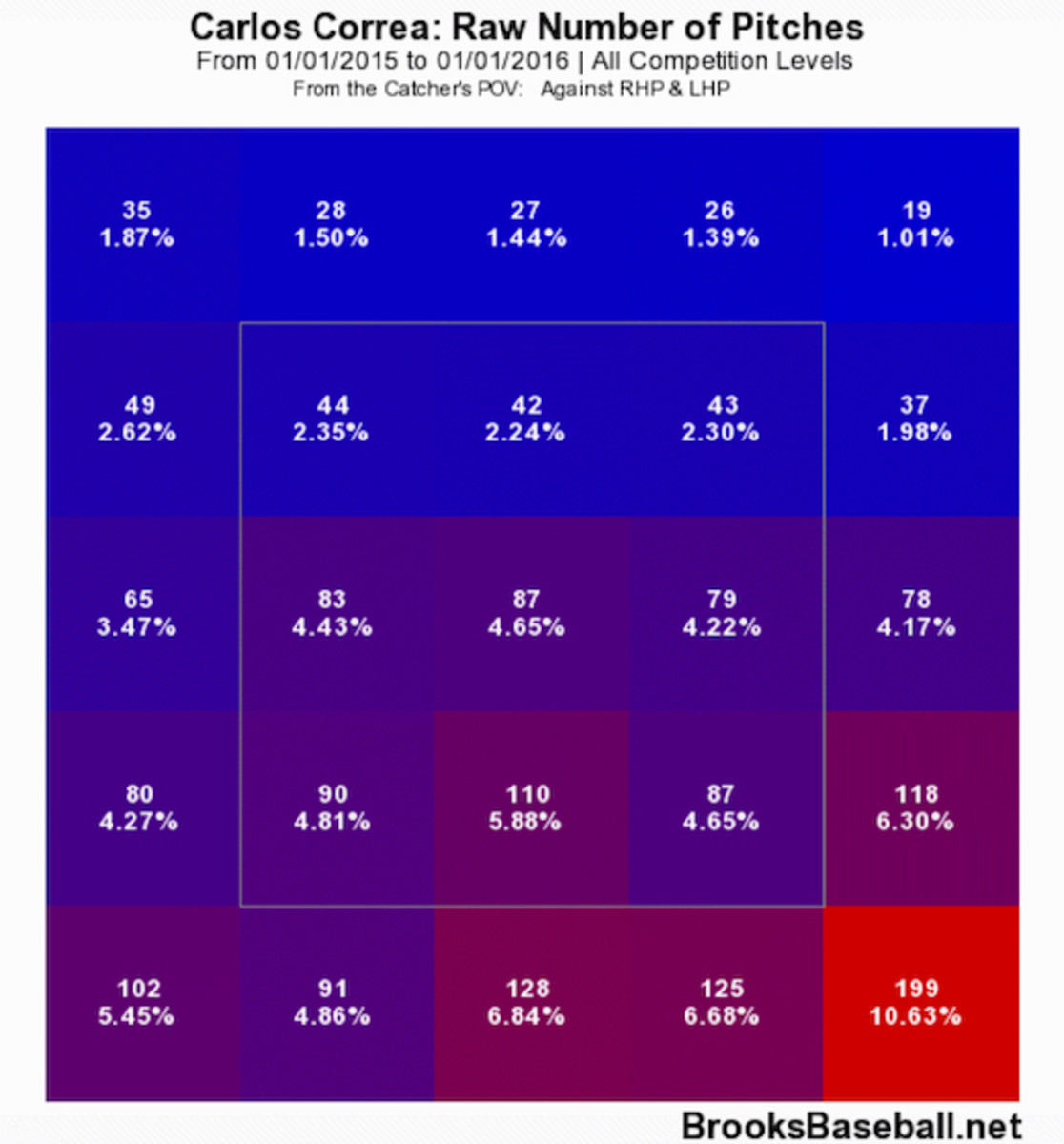
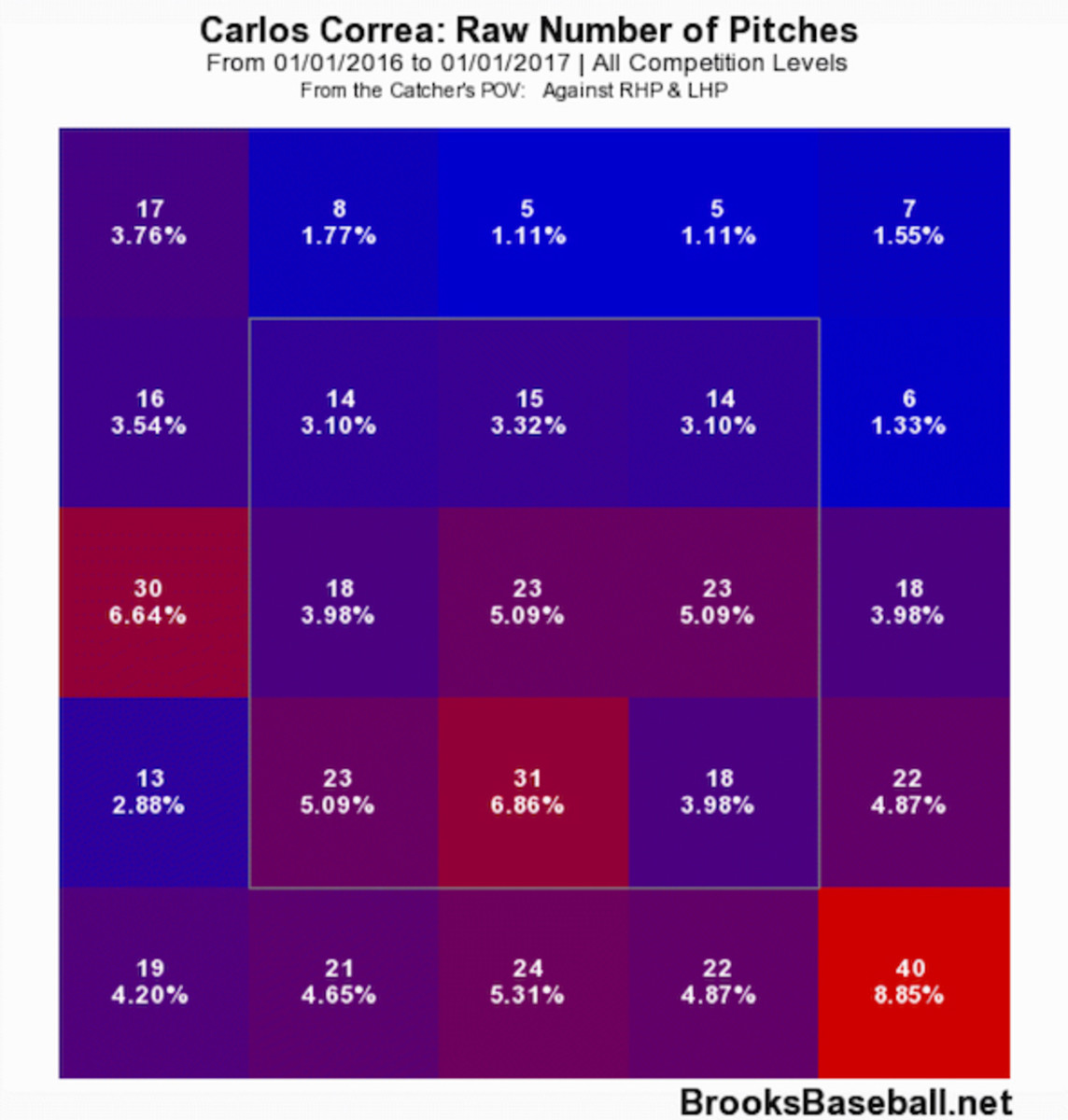
Add up the two leftmost columns and you get 35.63% in 2015 and 39.61% this year, an uptick of 11.2%. Let’s get back to the two at-bats, one from last year and one from this year, against Rodriguez of the A’s. Here’s good Correa, from last year.
Here’s bad Correa, from last weekend.
In case you couldn’t tell, here’s the exact location on that soft lineout.
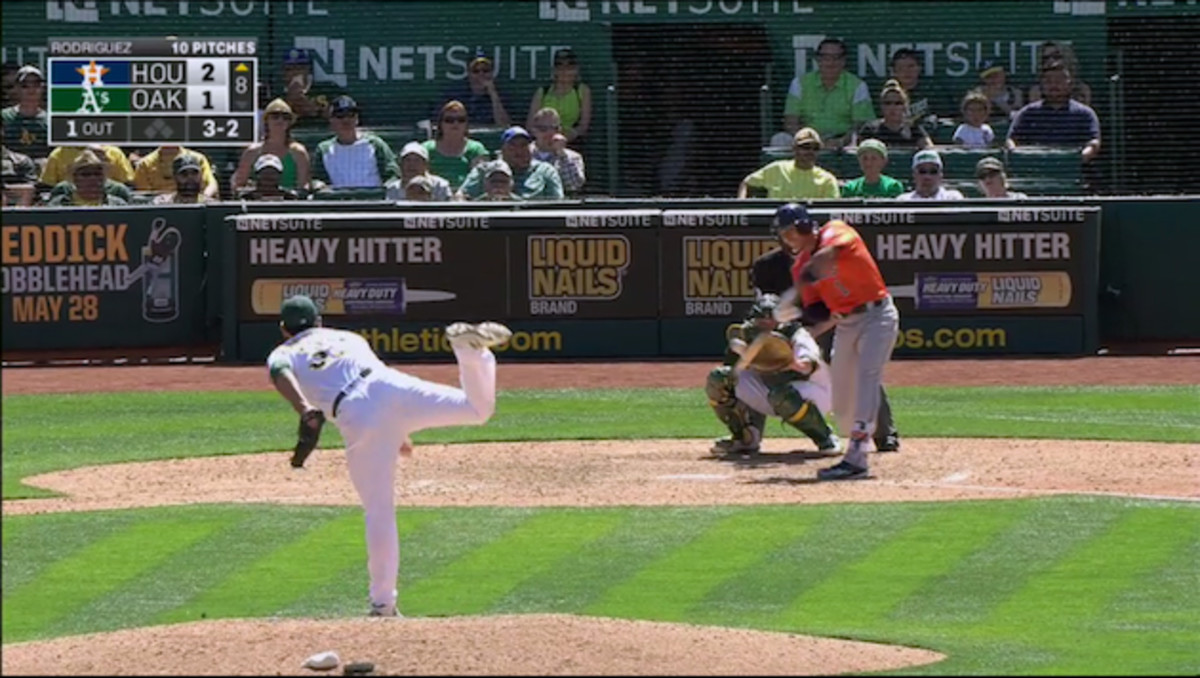
Opposing pitchers have made the adjustment. Assuming this is an issue, it’s now up to Correa to adjust back. The bet here is on him, and not pitchers at large, winning in the long term.
Hitters to watch this week
Nolan Arenado, 3B, Rockies
Arenado leads the majors in homers and RBI, and is second in runs. He’s hitting everything in sight and, as has always been the case, picking everything cleanly at third base. There may not be a better all-around player in the game today.
Edwin Encarnacion, 1B, Blue Jays
Encarnacion’s slow start to the season hasn’t gotten much notice, but it’s starting to get to a troubling point for his fantasy owners. He’s hitting just .235/.295/.373 with three homers, two of which came in the same game. Most alarmingly, his strikeout rate is up to 23.2%, while his walk rate is down at 8%. Entering this season, those metrics were at 18% and 12.9%, respectively, for his career. To be fair, he had a bad April last season, as well, before slugging better than .500 in four of the final months of the year.
Michael Conforto, OF, Mets
Rays SP Matt Moore finally returning to pre-Tommy John speeds
When is Conforto going to start getting mentioned alongside the best young hitters in the game? It’s true that he has given us a much smaller sample to work with thus far, but everything he has done suggests he’s going to be part of the huge group of young players who have changed the face of baseball over the last few seasons. In the first 79 games of his career, Conforto hit .292/.360/.541 with 13 homers and 25 doubles. As pointed out in this week’s edition of Jonah Keri’s The 30 (with help from a tweeter), neither Mike Trout nor Bryce Harper reached any of those thresholds in their first 78 games. Conforto looks like the real deal.
Michael Brantley, OF, Indians
Brantley made his season debut last week after opening the year on the DL with a shoulder injury, going 2-for-17 in his first 19 plate appearances. Obviously that’s far from ideal, but the good news is his shoulder seems to be completely healed, freeing Brantley up to be the all-around offensive force he turned into over the last two seasons. The fantasy community should be willing to cut Brantley a little slack as he shakes off the rust over the next few weeks. If he does continue to struggle, however, it would be worth it to see if his owner in your league starts to get a little jumpy.
Gregory Polanco, OF, Pirates
First, it was the improved plate discipline. Now, it’s the power. All of it is coming together for Polanco, in what is shaping up to be a breakout season. The 24-year-old is hitting .312/.412/.538 with three homers, nine doubles and a triple, not to mention more walks (18) than strikeouts (15). His walk rate is a borderline obscene 16.4%, and he’s making pitchers pay by forcing them to attack him in the zone. Pittsburgh’s outfield is officially the best in baseball.
Prospect watch
Willson Contreras, C, Cubs
The Cubs spent five years building the game’s preeminent farm system basically from scratch and finally started tapping into that vast reserve of talent last season. That doesn’t mean the cupboard is bare, however. Contreras entered the 2016 season as the No. 47 prospect, according to MLB.com, and he has shown why at Triple-A Iowa. In 17 games, Contreras is hitting .259/.432/.453 with six doubles and eight walks against eight strikeouts. There was a bit of a clamor for Contreras when the Cubs placed Miguel Montero on the DL last week, but the veteran catcher isn’t expected to miss much time, and the team wants to promote Contreras when it’s a long-term situation. If he keeps hitting the way he has to start the year, a promotion will likely come this season. At the same time, the Cubs could be looking to add to their roster at the trade deadline, and you can bet that teams will be interested in Contreras if and when the Cubs come calling. Contreras will likely make his MLB debut this season, and no matter what team it’s with, he’s going to be an intriguing fantasy option.
GIF of the Week
Yeah, we’ve seen this from Brandon Phillips before. It never gets old.
